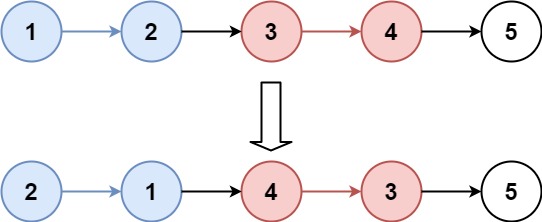给你一个链表的头节点
head,旋转链表,将链表每个节点向右移动k个位置。示例 1:
输入:head = [1,2,3,4,5], k = 2 输出:[4,5,1,2,3]示例 2:
输入:head = [0,1,2], k = 4 输出:[2,0,1]提示:
- 链表中节点的数目在范围
[0, 500]内-100 <= Node.val <= 1000 <= k <= 2 * 109
思路:看图片可以发现,这个题目本质上,是把链表分成两部分,交换前后两部分的顺序
所以重点在于找到分裂点,以及拼接
/**
* Definition for singly-linked list.
* struct ListNode {
* int val;
* ListNode *next;
* ListNode() : val(0), next(nullptr) {}
* ListNode(int x) : val(x), next(nullptr) {}
* ListNode(int x, ListNode *next) : val(x), next(next) {}
* };
*/
class Solution {
public:
ListNode* rotateRight(ListNode* head, int k) {
if(!head || !head->next || k == 0) {
return head;
}
auto tmp = head;
int count = 0;
auto tail = head;
while(tmp) {
tail = tmp;
tmp = tmp->next;
++count;
}
tmp = head;
k %= count;
if(k == 0) {
return head;
}
k = count - k;
while(--k && tmp) {
tmp = tmp->next;
}
auto new_head = tmp->next;
tmp->next = nullptr;
tail->next = head;
return new_head;
}
};给你单链表的头节点
head,请你反转链表,并返回反转后的链表。示例 1:
输入:head = [1,2,3,4,5] 输出:[5,4,3,2,1]示例 2:
输入:head = [1,2] 输出:[2,1]示例 3:
输入:head = [] 输出:[]提示:
- 链表中节点的数目范围是
[0, 5000]-5000 <= Node.val <= 5000进阶:链表可以选用迭代或递归方式完成反转。你能否用两种方法解决这道题?
思路:递归法比较简单,还是我们的老模板
void circle(ListNode *head) {
if(...) {
return
} //边界条件
auto res = circle(head->next);
//other code
//return
}迭代法也是一器破万法。
关于链表反转的题目,都分成两部分,pre和curr
pre就是已经处理好的部分的尾节点, curr就是你要处理的部分的头节点
所以伪代码如下
//关于翻转链表相关的题目
while(xxx) {
process(curr); //实现翻转的逻辑
pre = curr; //当前部分已经处过,所以pre变成curr
curr = curr->next; //curr->next还没处理过,所以curr指向自己的next继续处理
}/**
* Definition for singly-linked list.
* struct ListNode {
* int val;
* ListNode *next;
* ListNode() : val(0), next(nullptr) {}
* ListNode(int x) : val(x), next(nullptr) {}
* ListNode(int x, ListNode *next) : val(x), next(next) {}
* };
*/
class Solution {
public:
ListNode* reverseList(ListNode* head) {
if(!head || !head->next) {
return head;
}
// auto next = reverseList(head->next);
// auto tmp = head->next;
// head->next = nullptr;
// tmp->next = head;
// return next;
auto pre = head;
pre = nullptr;
while(head) {
auto next = head->next;
head->next = nullptr;
head->next = pre;
pre = head;
head = next;
}
return pre;
}
};给你单链表的头指针
head和两个整数left和right,其中left <= right。请你反转从位置left到位置right的链表节点,返回 反转后的链表 。示例 1:
输入:head = [1,2,3,4,5], left = 2, right = 4 输出:[1,4,3,2,5]示例 2:
输入:head = [5], left = 1, right = 1 输出:[5]提示:
- 链表中节点数目为
n1 <= n <= 500-500 <= Node.val <= 5001 <= left <= right <= n进阶: 你可以使用一趟扫描完成反转吗?
思路,和上题一样,不过是对翻转的区间有限制了。
加上前缀节点pre,找到要翻转的区间的头尾节点,将之翻转后。拼接回原来的链表
/**
* Definition for singly-linked list.
* struct ListNode {
* int val;
* ListNode *next;
* ListNode() : val(0), next(nullptr) {}
* ListNode(int x) : val(x), next(nullptr) {}
* ListNode(int x, ListNode *next) : val(x), next(next) {}
* };
*/
class Solution {
public:
ListNode* reverseBetween(ListNode* head, int left, int right) {
if(!head || !head->next) {
return head;
}
auto tmp = new ListNode(-1);
tmp->next = head;
auto pre = tmp;
int count = left;
while(--count) {
tmp = tmp->next;
}
auto curr = tmp->next;
for(int i=0; i<right-left; i++) {
auto tail = curr->next->next;
auto next = curr->next;
curr->next = tail;
auto new_tail = tmp->next;
tmp->next = next;
next->next = new_tail;
}
return pre->next;
}
};给你一个链表,两两交换其中相邻的节点,并返回交换后链表的头节点。你必须在不修改节点内部的值的情况下完成本题(即,只能进行节点交换)。
示例 1:
输入:head = [1,2,3,4] 输出:[2,1,4,3]示例 2:
输入:head = [] 输出:[]示例 3:
输入:head = [1] 输出:[1]提示:
- 链表中节点的数目在范围
[0, 100]内0 <= Node.val <= 100
思路:还记得我们一器破万法的迭代法模板吗,直接套用就可以
/**
* Definition for singly-linked list.
* struct ListNode {
* int val;
* ListNode *next;
* ListNode() : val(0), next(nullptr) {}
* ListNode(int x) : val(x), next(nullptr) {}
* ListNode(int x, ListNode *next) : val(x), next(next) {}
* };
*/
class Solution {
public:
ListNode* swapPairs(ListNode* head) {
if(!head || !head->next) {
return head;
}
auto pre = new ListNode(-1);
pre->next = head;
auto curr = head;
auto tmp = pre;
while(curr && curr->next) {
auto tail = curr->next->next;
auto next = curr->next;
curr->next = tail;
auto new_tail = tmp->next;
next->next = new_tail;
tmp->next = next;
tmp = curr;
curr = curr->next;
}
return pre->next;
}
};给你链表的头节点
head,每k个节点一组进行翻转,请你返回修改后的链表。
k是一个正整数,它的值小于或等于链表的长度。如果节点总数不是k的整数倍,那么请将最后剩余的节点保持原有顺序。你不能只是单纯的改变节点内部的值,而是需要实际进行节点交换。
示例 1:
输入:head = [1,2,3,4,5], k = 2 输出:[2,1,4,3,5]示例 2:
输入:head = [1,2,3,4,5], k = 3 输出:[3,2,1,4,5]提示:
- 链表中的节点数目为
n1 <= k <= n <= 50000 <= Node.val <= 1000进阶:你可以设计一个只用
O(1)额外内存空间的算法解决此问题吗?
思路:做了以上几道题目,总结了自己的一器破万法模板之后,发现这个题竟然这么简单
以前被自己视为面试杀手的接雨水,k个一组翻转链表也变得简单起来
这题和上一题的唯一不同就在于,需要遍历一遍算出链表的长度,避免越界
/**
* Definition for singly-linked list.
* struct ListNode {
* int val;
* ListNode *next;
* ListNode() : val(0), next(nullptr) {}
* ListNode(int x) : val(x), next(nullptr) {}
* ListNode(int x, ListNode *next) : val(x), next(next) {}
* };
*/
class Solution {
public:
ListNode* reverseKGroup(ListNode* head, int k) {
auto tmp = head;
int count=0;
while(tmp) {
++count;
tmp = tmp->next;
}
if(!head || !head->next || k>count || k<=1) {
return head;
}
auto pre = new ListNode(-1);
pre->next = head;
tmp = pre;
auto curr = head;
for(int i=0; i<count/k; i++) {
for(int j=1; j<k; j++) {
auto tail = curr->next->next;
auto next = curr->next;
curr->next = tail;
auto new_tail = tmp->next;
next->next = new_tail;
tmp->next = next;
}
tmp = curr;
curr = curr->next;
}
return pre->next;
}
};




























 856
856

 被折叠的 条评论
为什么被折叠?
被折叠的 条评论
为什么被折叠?








